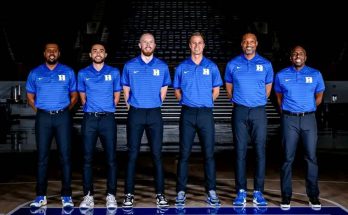The drama swirling around Ohio State’s highly anticipated season opener against Texas has taken an unexpected turn with news that Barstool Sports founder Dave Portnoy is reportedly being barred from Ohio Stadium. According to sources who spoke to Front Office Sports, Portnoy, one of the most polarizing figures in sports media, will not be allowed to attend the marquee game between two of the nation’s biggest programs. The revelation has ignited a wave of controversy and conversation in both college football and media circles, raising questions about access, image control, and the complex relationship between universities and outspoken media personalities.
Dave Portnoy, known widely as “El Presidente” of Barstool Sports, has long been a lightning rod for debate in the sports world. His brand’s rise from a small gambling-focused newspaper in Boston to a multi-million-dollar media empire has been built on brash, unapologetic commentary and a style that blurs the lines between journalism, entertainment, and fandom. With Portnoy’s persona tied so closely to Barstool’s identity, every move he makes garners attention, and every time an institution pushes back against him, it becomes part of the ongoing saga of Portnoy versus the establishment. Ohio State appears to be the latest to enter that storyline.
The decision to reportedly bar him from entering the stadium comes at a time when Ohio State is preparing for one of its biggest non-conference games in recent memory. A showdown with Texas, two blueblood programs with national championship aspirations, is set to capture the attention of the college football world. With playoff implications on the line in week one, the Buckeyes are under immense pressure to set the tone for their season. Adding Portnoy into that environment, given his reputation for creating media storms, may have been a distraction Ohio State’s leadership wasn’t willing to entertain.
But the question many are asking is why? What about Portnoy’s presence is so threatening that Ohio State would risk the backlash of appearing to “ban” him outright? The answer isn’t simple, but it may lie in a combination of public image concerns, prior controversies, and the evolving dynamics between traditional athletic departments and new-age media.
Portnoy has had a complicated history with access to major sporting events. He has previously clashed with the NFL, particularly during the infamous “Deflategate” saga involving Tom Brady and the New England Patriots. Barstool Sports was also known for being banned from Super Bowl media day in past years due to disruptive stunts. The same tension has played out in college sports, where some universities have resisted granting legitimacy to Barstool’s coverage given the network’s sometimes unfiltered, controversial tone. While millions of fans adore Barstool’s irreverence, universities with carefully crafted public relations strategies often see it as a risk.
Ohio State, as one of the premier brands in college athletics, has always been careful about image and reputation management. From the way the Buckeyes recruit and market their program to how they present themselves nationally, the school has historically taken a tightly controlled approach. In barring Portnoy, it seems Ohio State is sending a message that while it welcomes national attention, it wants to dictate the terms of who gets a platform within its stadium. Whether this is a targeted move against Portnoy himself or a broader stand against Barstool’s brand of coverage is still unclear, but the optics are unmistakable: Ohio State doesn’t want to be associated with Portnoy on one of its biggest stages.
Naturally, the reaction to the report has been swift. Supporters of Portnoy and Barstool see this as yet another example of “the establishment” trying to silence a voice that doesn’t play by traditional media rules. They argue that Portnoy has as much right as any other media figure to attend the game, especially since Barstool commands one of the largest audiences in sports media. Critics, however, view Ohio State’s decision as justified, pointing to Portnoy’s history of controversy, his combative social media presence, and the potential for unwanted spectacle. The polarization mirrors the larger conversation about Barstool itself—a brand adored by its loyal fan base but often dismissed or rejected by institutions wary of reputational risk.
Another layer to this story is the timing. College football in 2025 looks very different than it did just a decade ago. With the expansion of the College Football Playoff, realignment shaking the landscape, and the rise of NIL money transforming recruiting, the sport has become more media-driven than ever. Traditional powerhouses like Ohio State are constantly negotiating how they interact with this new environment. The growing influence of independent and digital-first outlets like Barstool presents both opportunity and threat. On one hand, Barstool can deliver unmatched access to a younger demographic that athletic departments crave. On the other hand, relinquishing any level of control to an outlet that thrives on shock value is something schools like Ohio State resist.
For Portnoy, being barred from Ohio Stadium may be more of a badge of honor than a setback. Historically, he has used these moments of exclusion to rally his fan base and strengthen the Barstool brand as an outsider fighting against establishment forces. In fact, one can expect Portnoy to leverage this report to his advantage, whether through his podcast, social media, or Barstool’s network of content creators. What was meant as a move by Ohio State to keep him out of the spotlight may ironically ensure he becomes an even bigger storyline in the lead-up to kickoff.
The bigger issue at play here is what this says about access and freedom in the modern sports media landscape. When does a university have the right to deny entry to a public figure, even one as controversial as Portnoy? What precedent does this set for future coverage, particularly as non-traditional media continues to rise? And does barring Portnoy achieve Ohio State’s goal of keeping the focus on the game, or does it actually do the opposite by sparking days of conversation about him instead of football? These are the questions swirling now as fans, journalists, and commentators weigh in.
It’s also worth considering the potential legal and contractual angles. If Portnoy had acquired tickets legitimately, could Ohio State enforce a ban without grounds? If this is about media credentials rather than general admission, that would make more sense, as schools have wide discretion over which outlets to grant press access. But if the ban extends to Portnoy entering as a fan, then the controversy deepens. It raises concerns about discrimination and selective enforcement, especially when thousands of other ticket holders will be allowed entry without scrutiny. This gray area between private control of stadium access and the public nature of large university events is where the debate gets more complicated.
From a cultural standpoint, this clash highlights the ongoing tension between old and new media. Barstool represents the disruptive, personality-driven, internet-fueled approach that appeals to younger fans and operates outside traditional rules. Ohio State, meanwhile, embodies tradition, order, and institutional authority. When the two collide, sparks fly, and the outcome often says more about the changing nature of sports than about the specific individuals involved.
As kickoff approaches, the spotlight on Ohio Stadium will only grow brighter. Fans are already buzzing about the implications of the game itself: Can Ohio State’s offense deliver in front of a national audience? Will Texas prove it belongs in the upper echelon of the sport as the Longhorns settle into their SEC identity? Yet now, layered on top of the football narratives is this off-field subplot involving Portnoy. Even if he never sets foot in the stadium, his name will hang over the broadcast, the commentary, and the fan discourse.
Ultimately, Ohio State’s reported move to bar Portnoy may achieve mixed results. On one hand, it reinforces the school’s ability to control its environment and stand firm against personalities it deems problematic. On the other, it risks alienating a significant portion of fans who view Portnoy as harmless entertainment and who resent what they see as heavy-handed censorship. The truth likely lies somewhere in between, with Ohio State making a calculated choice that the potential fallout from Portnoy’s presence outweighed the backlash from barring him.
No matter how one views it, this episode is yet another reminder of how college football is no longer just about what happens between the lines. The culture, media narratives, and personalities surrounding the sport are increasingly inseparable from the games themselves. Dave Portnoy may not be on the field when Ohio State and Texas battle in Columbus, but in many ways, he has already become part of the story. And in the unpredictable, media-saturated world of modern sports, that may have been inevitable all along.



